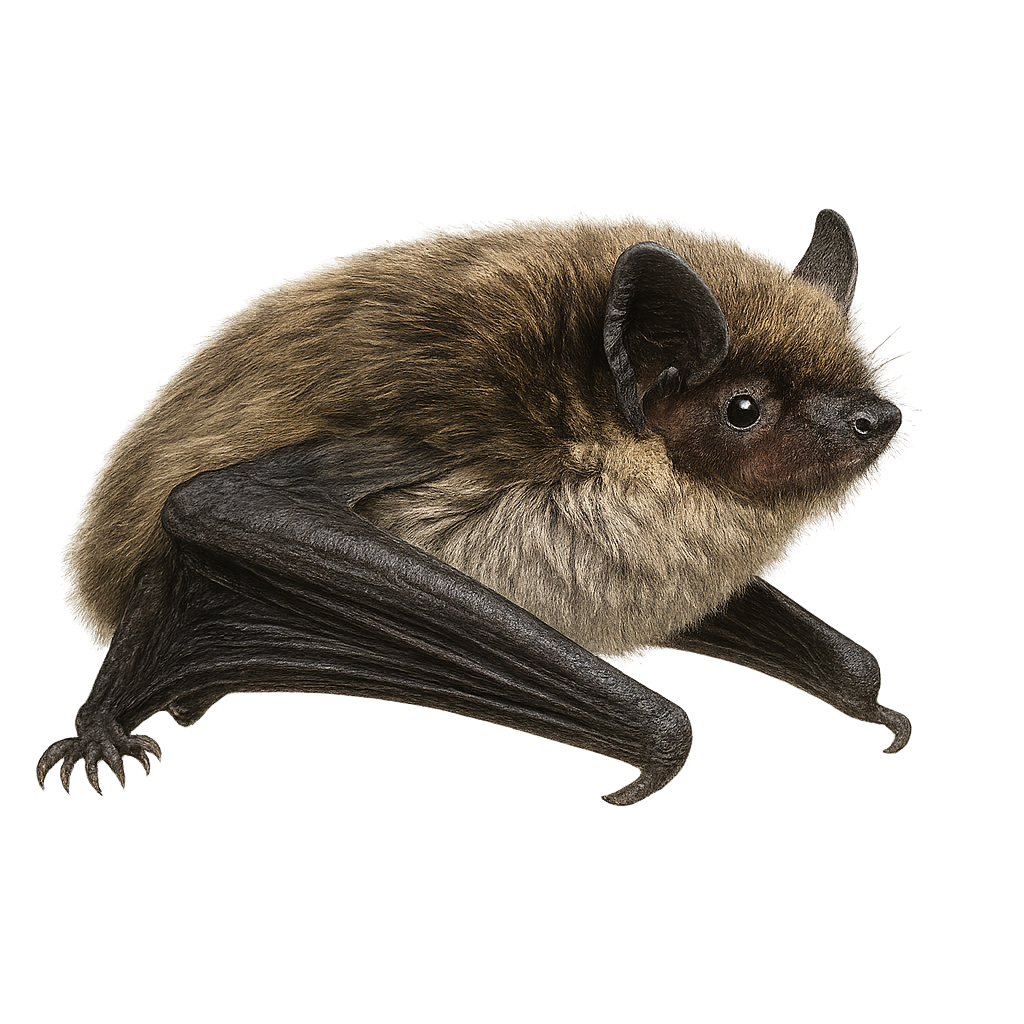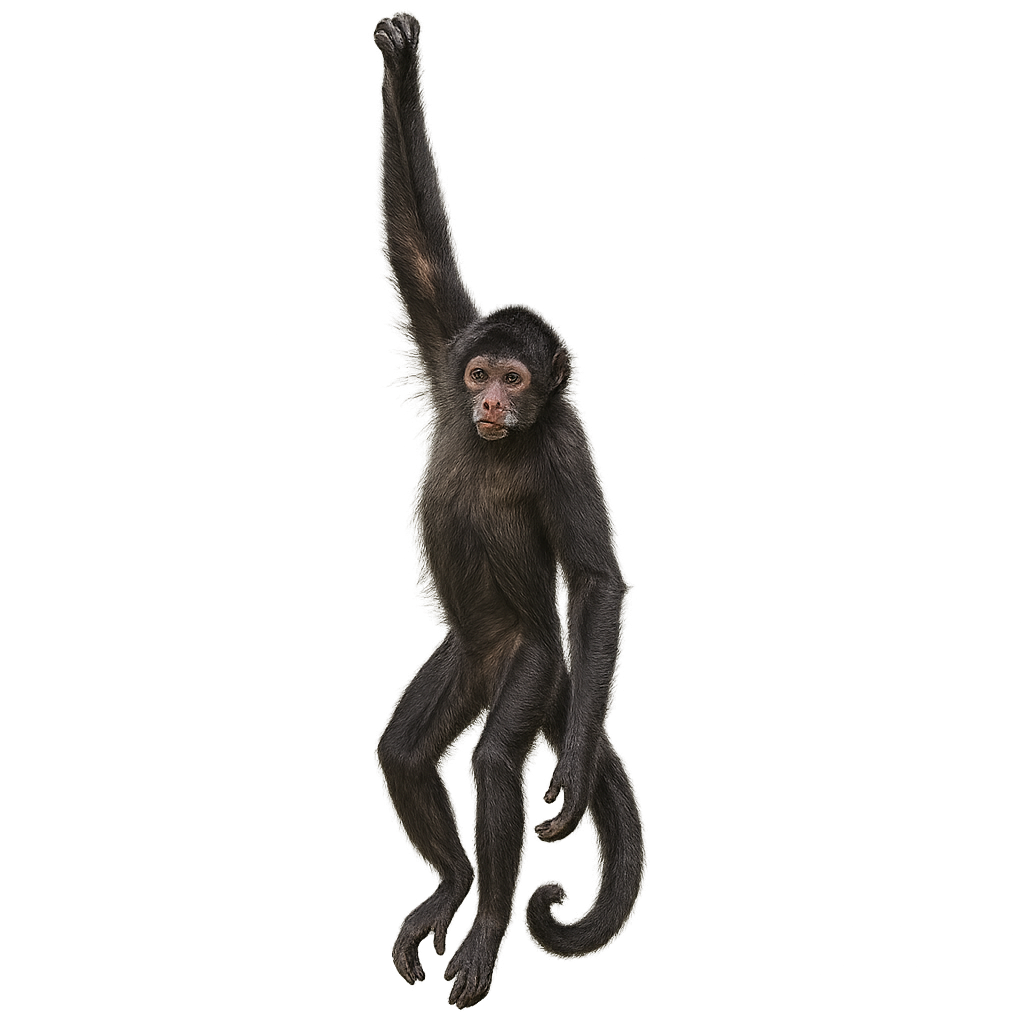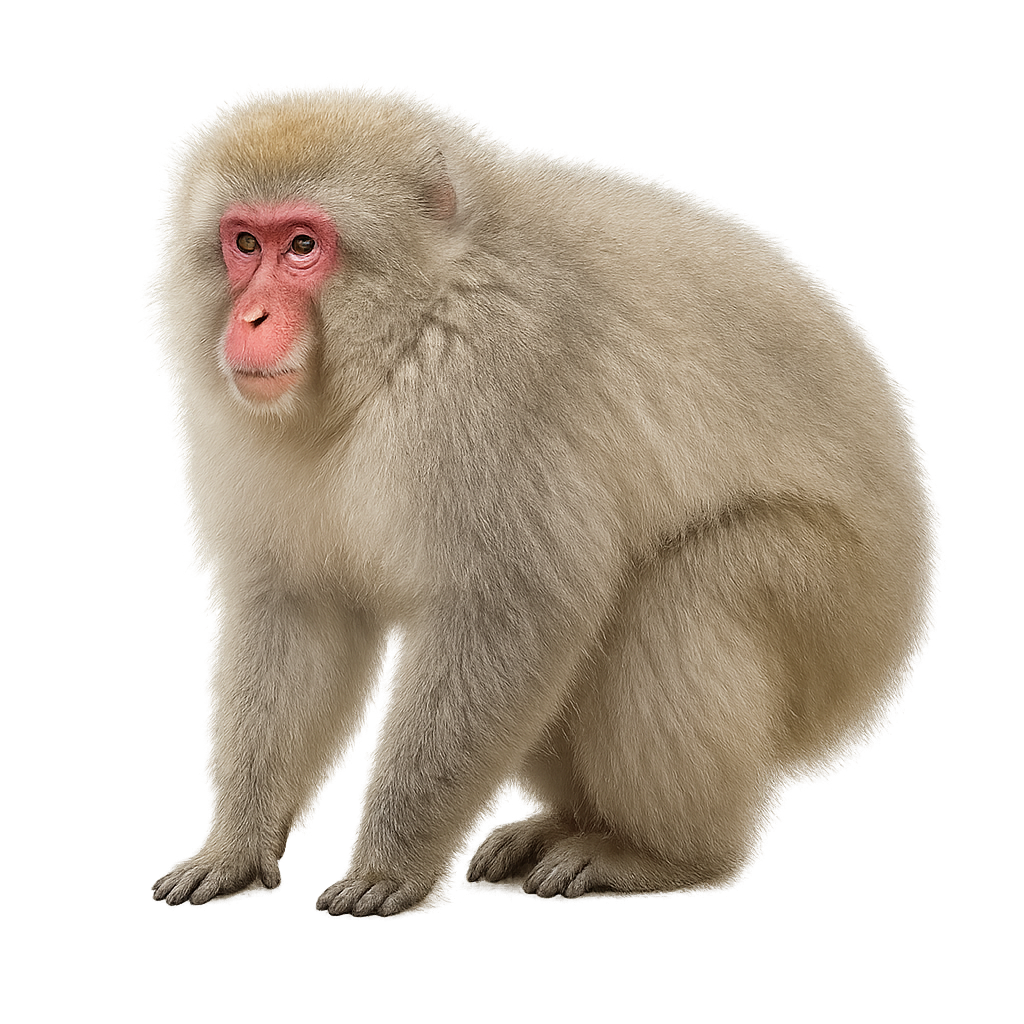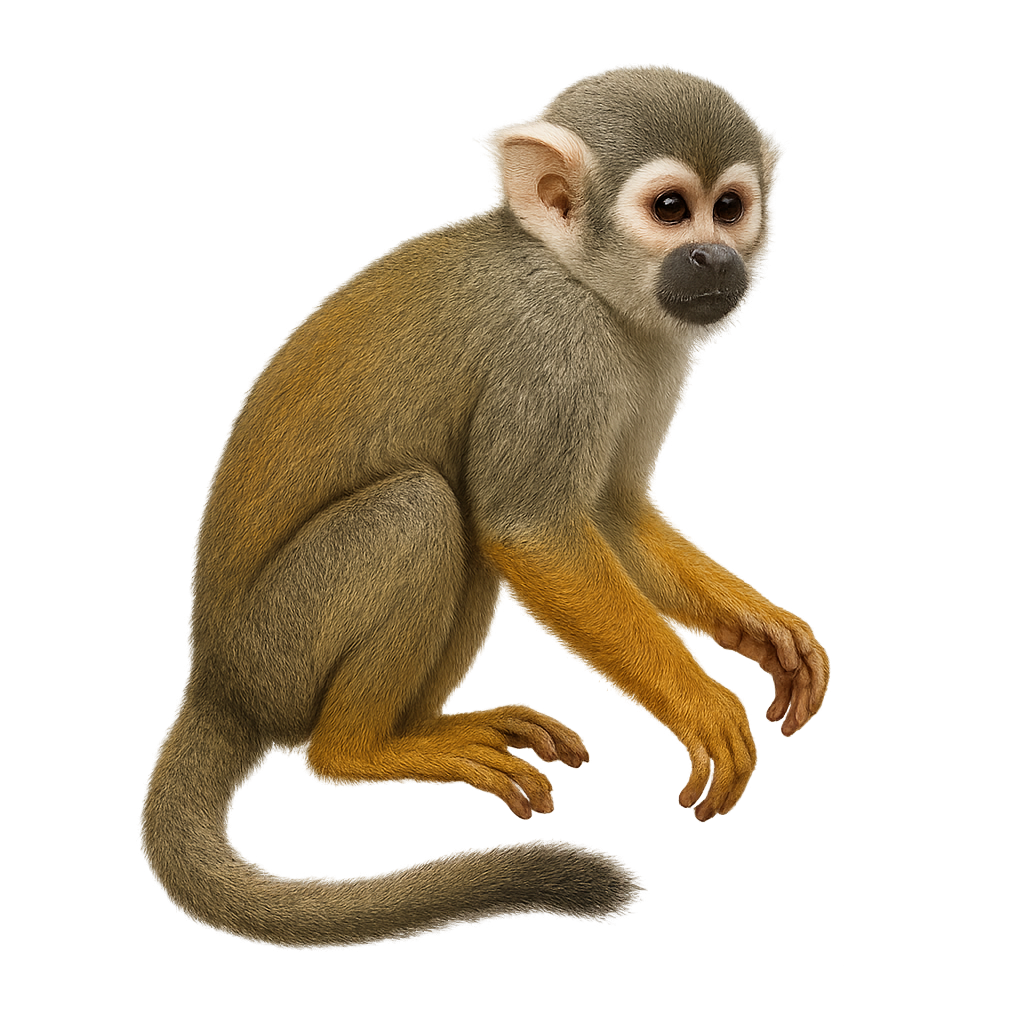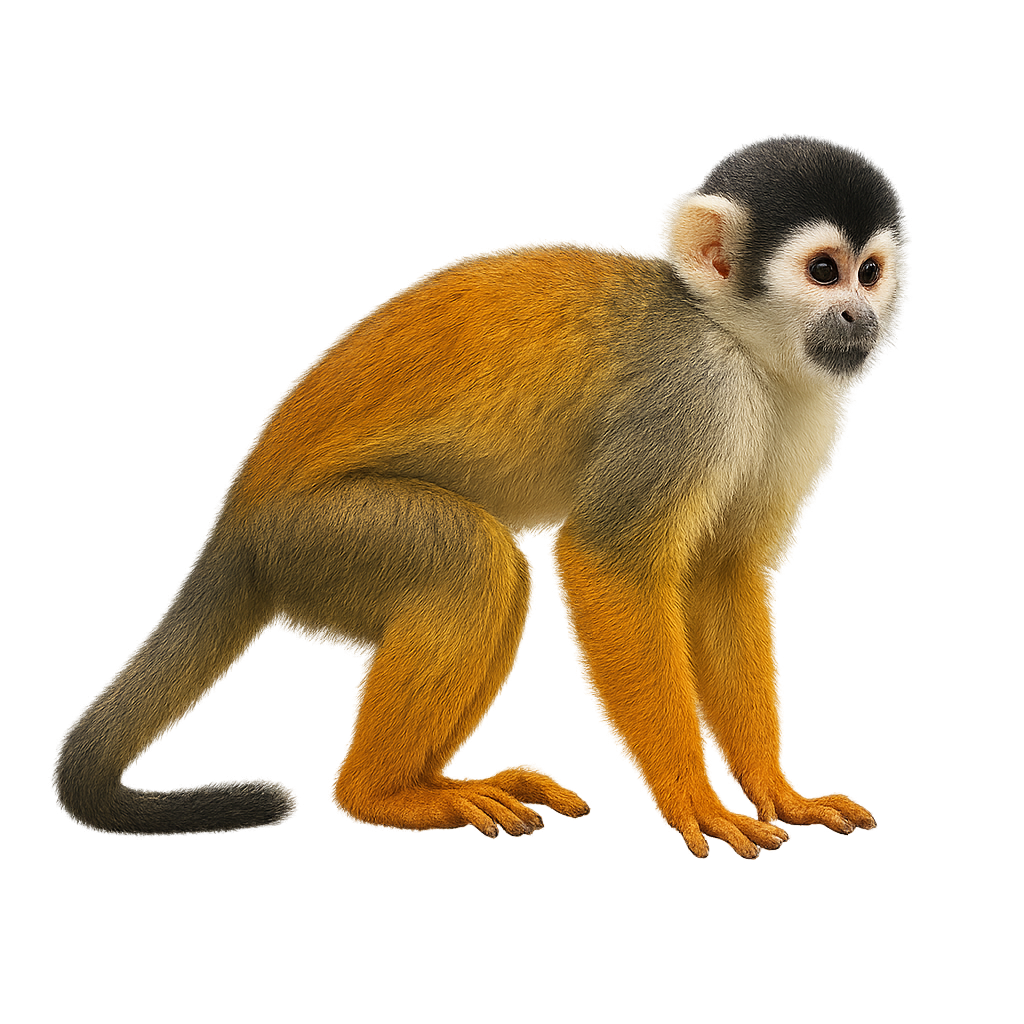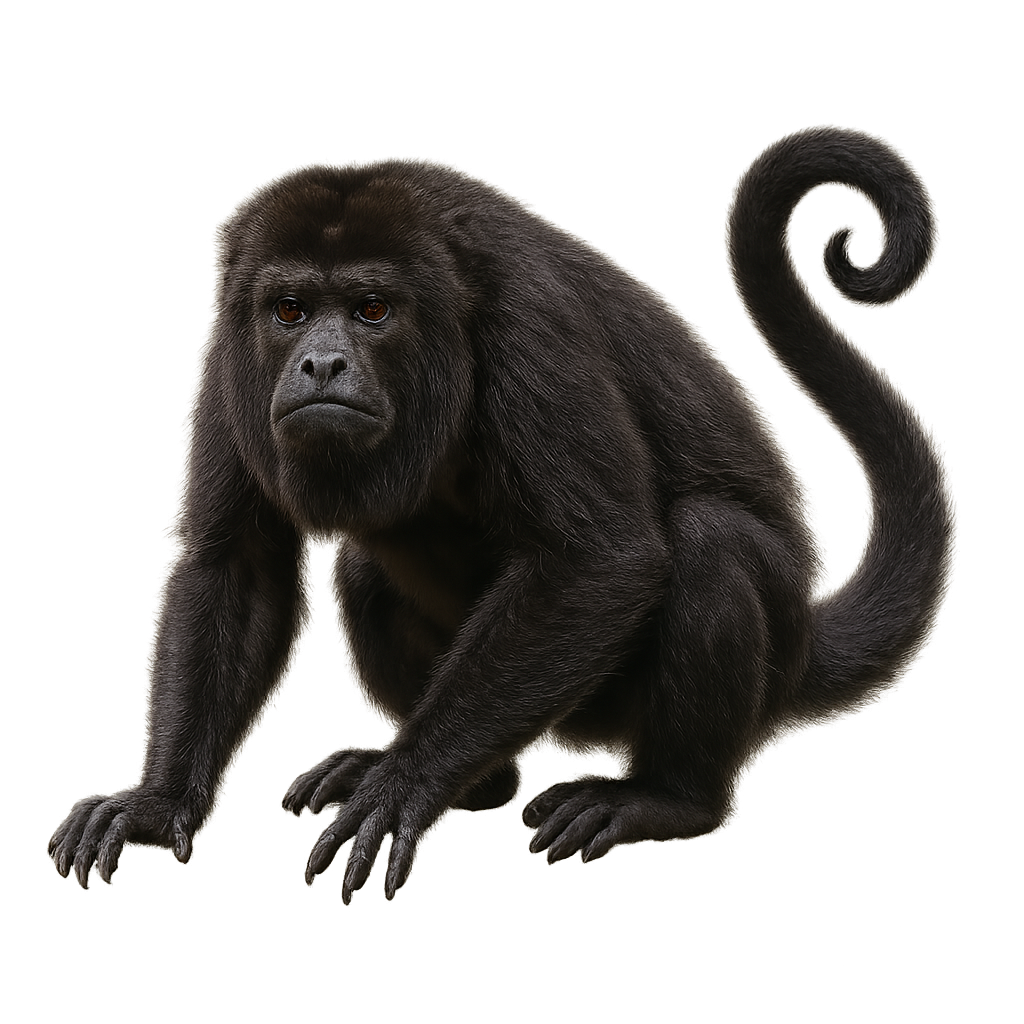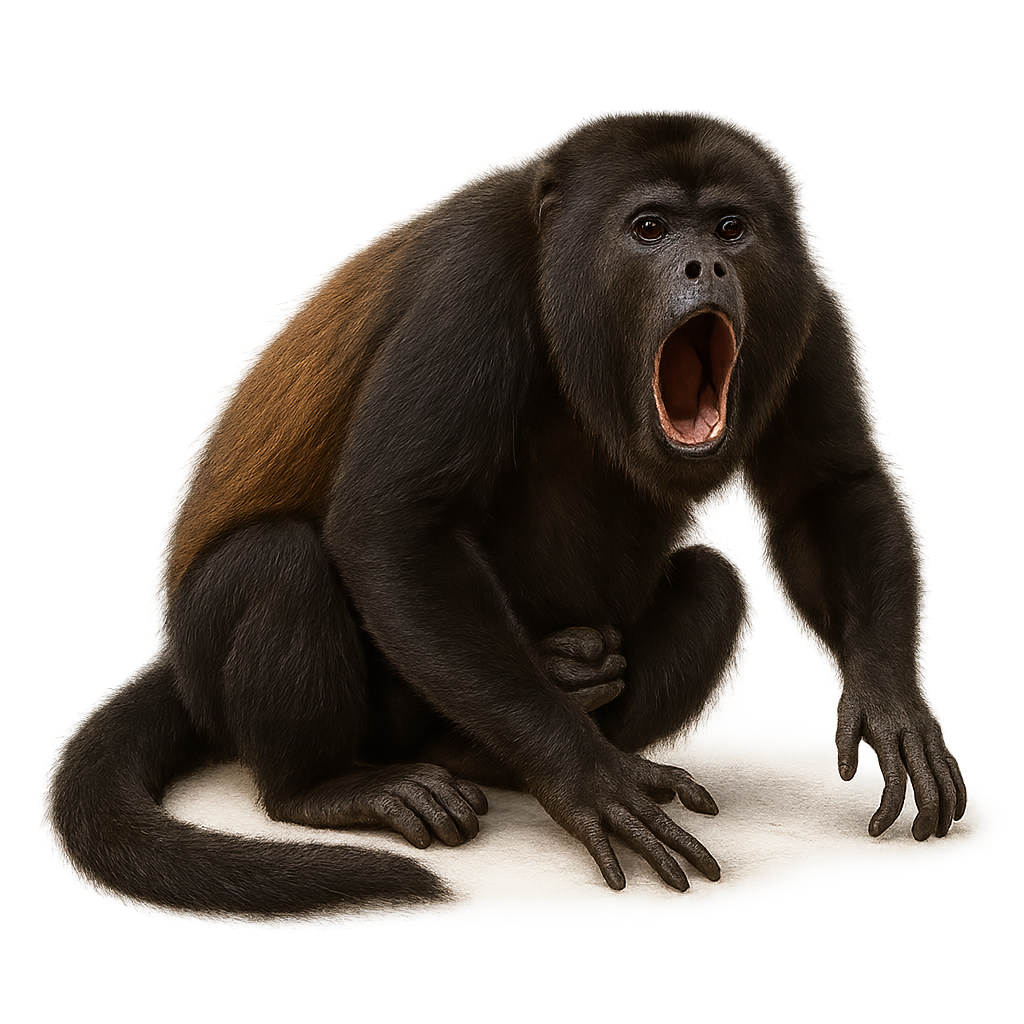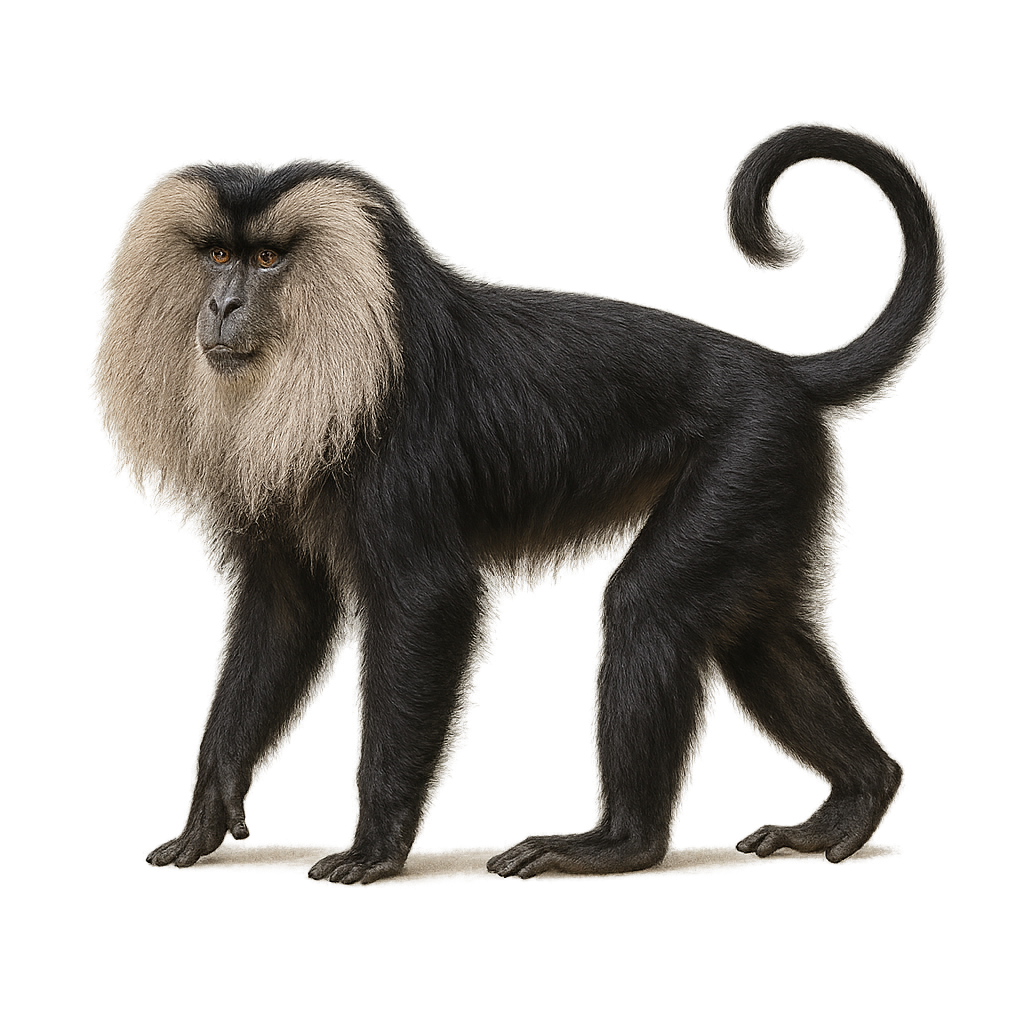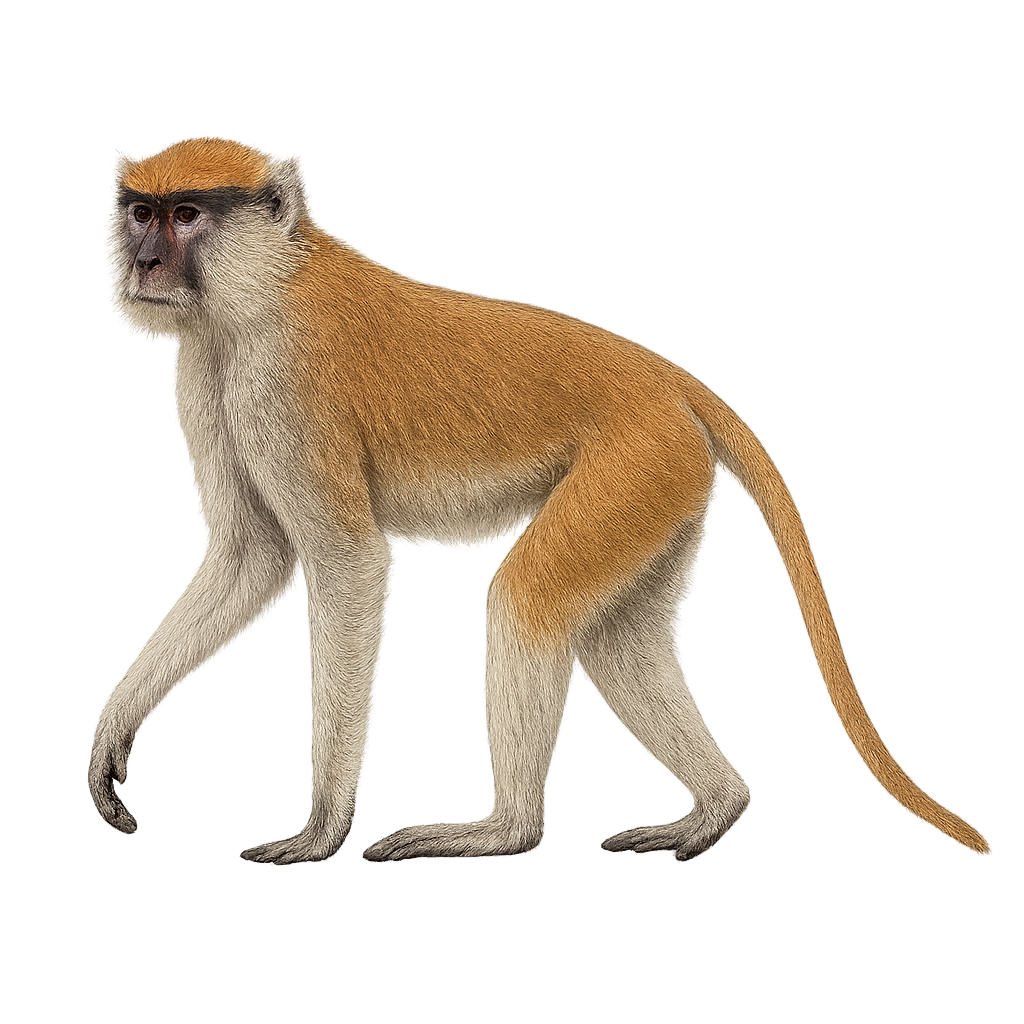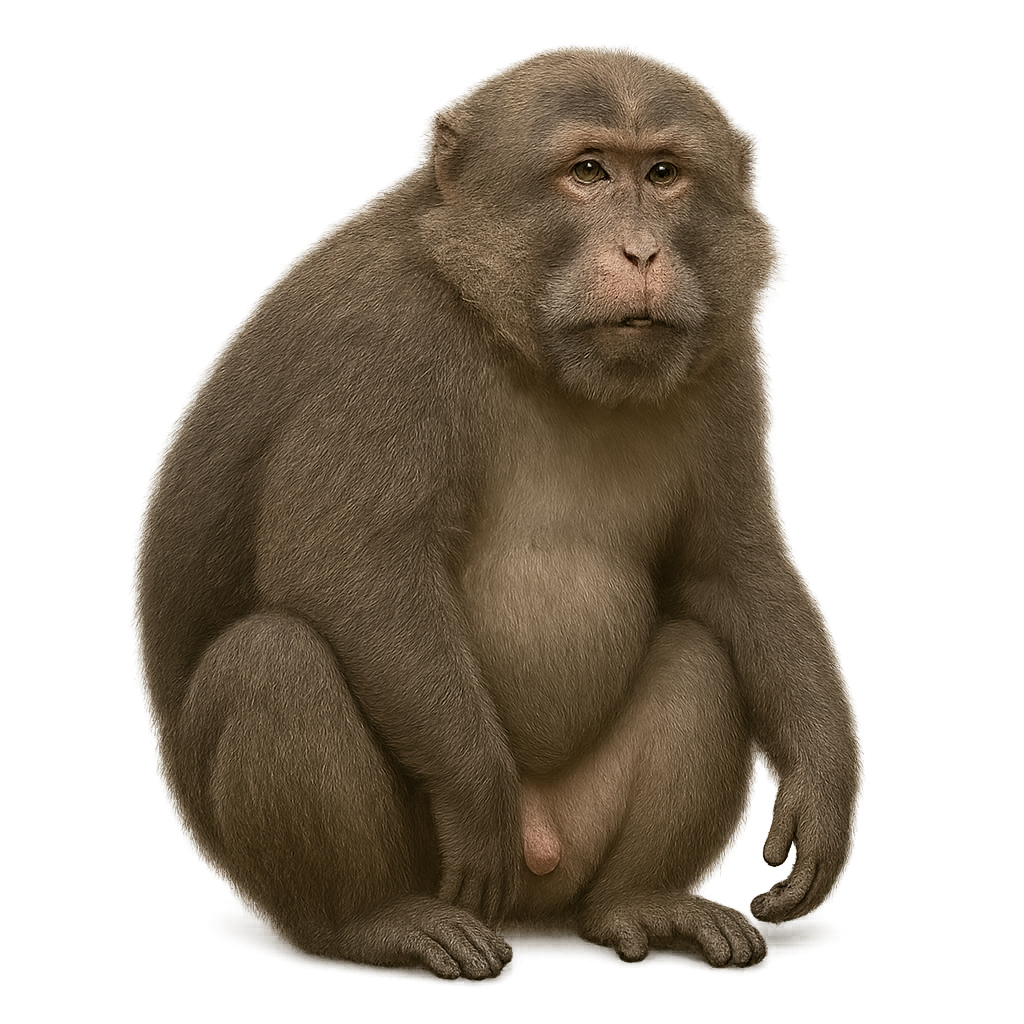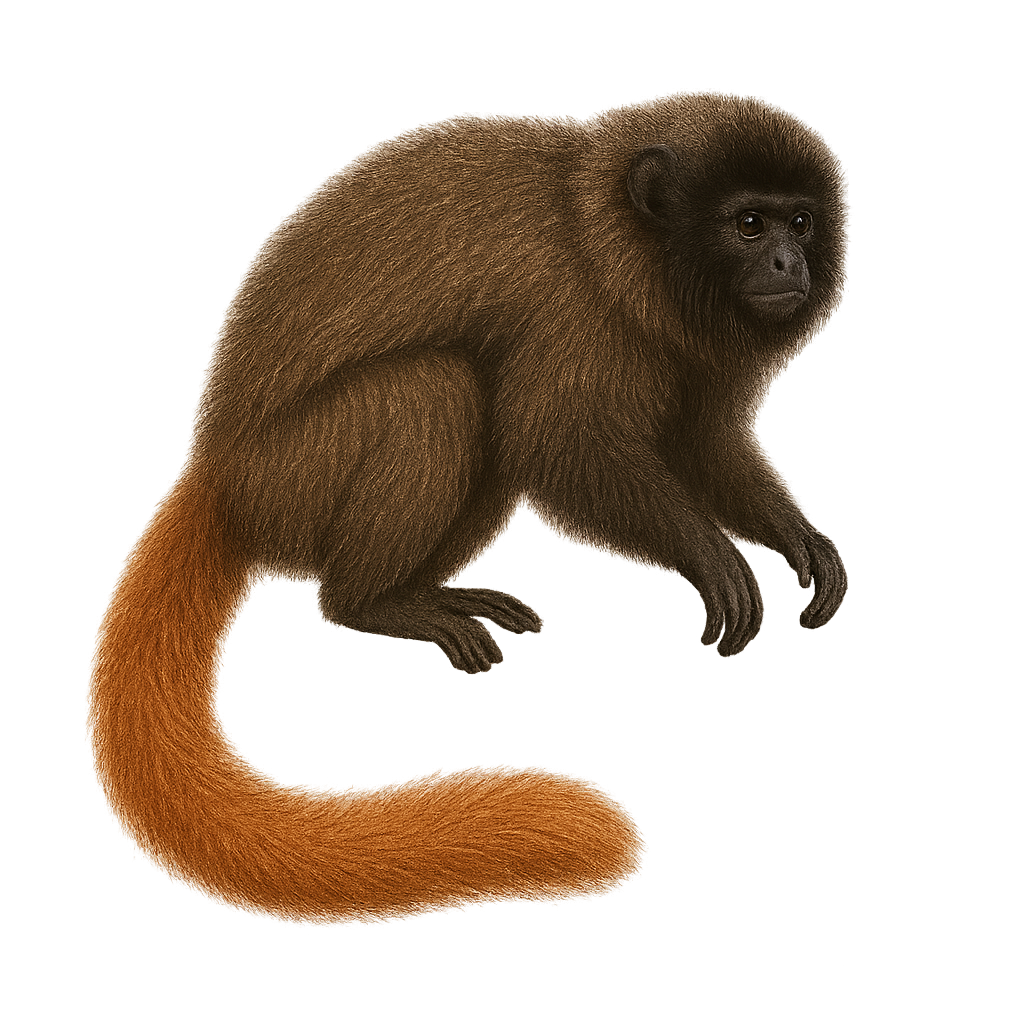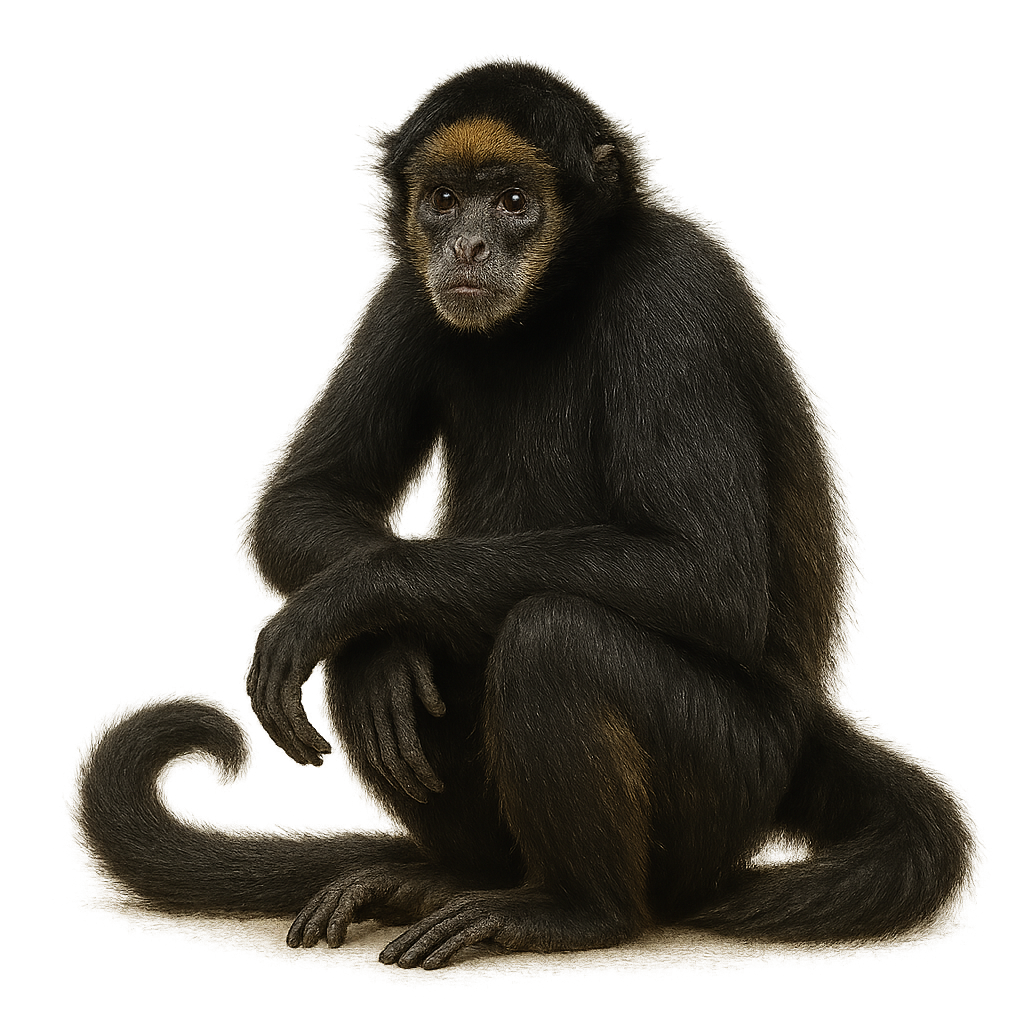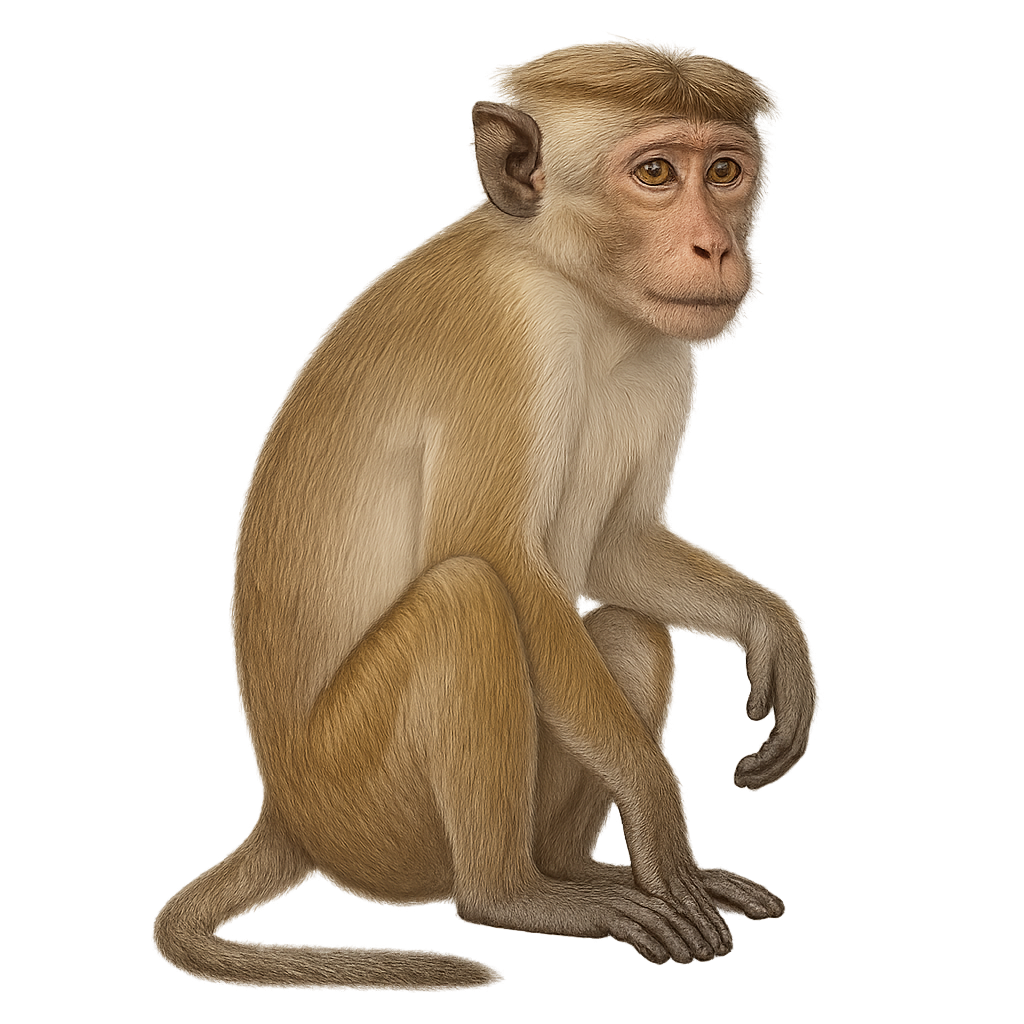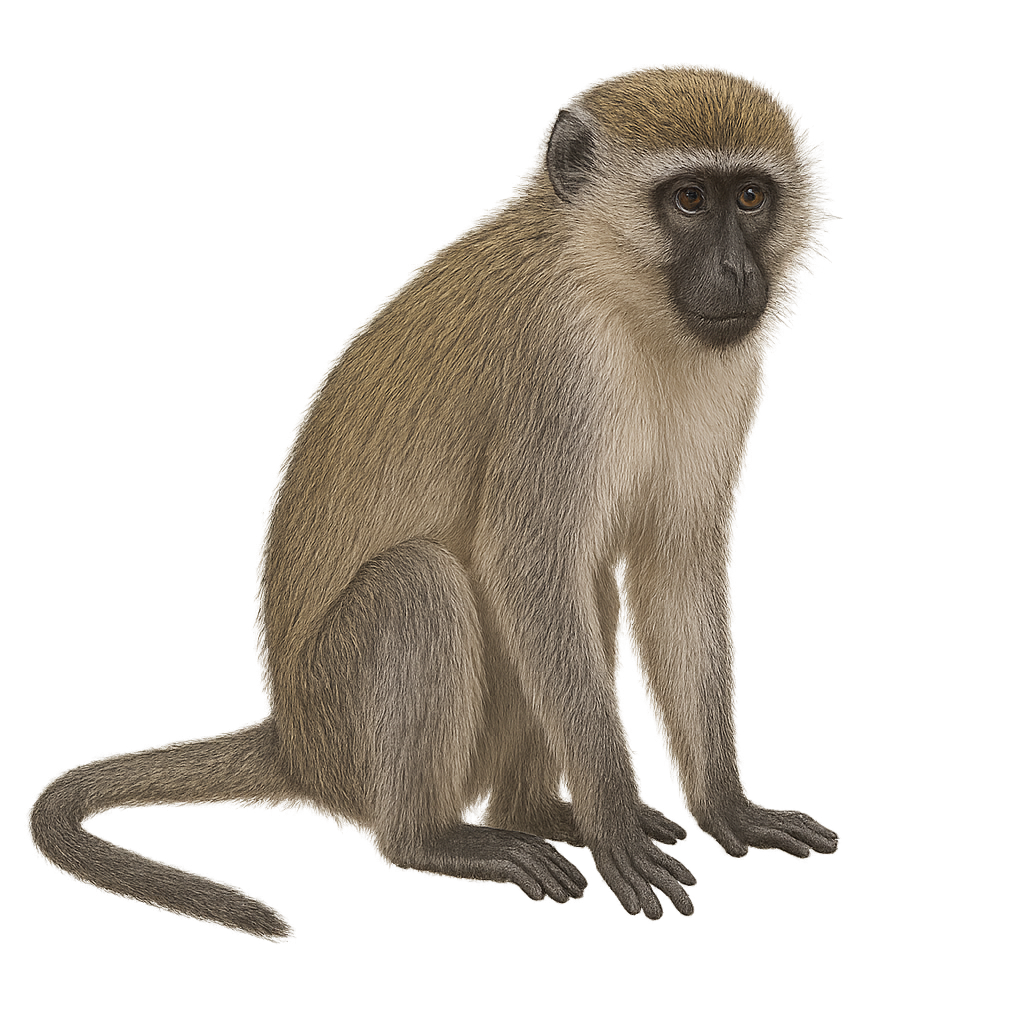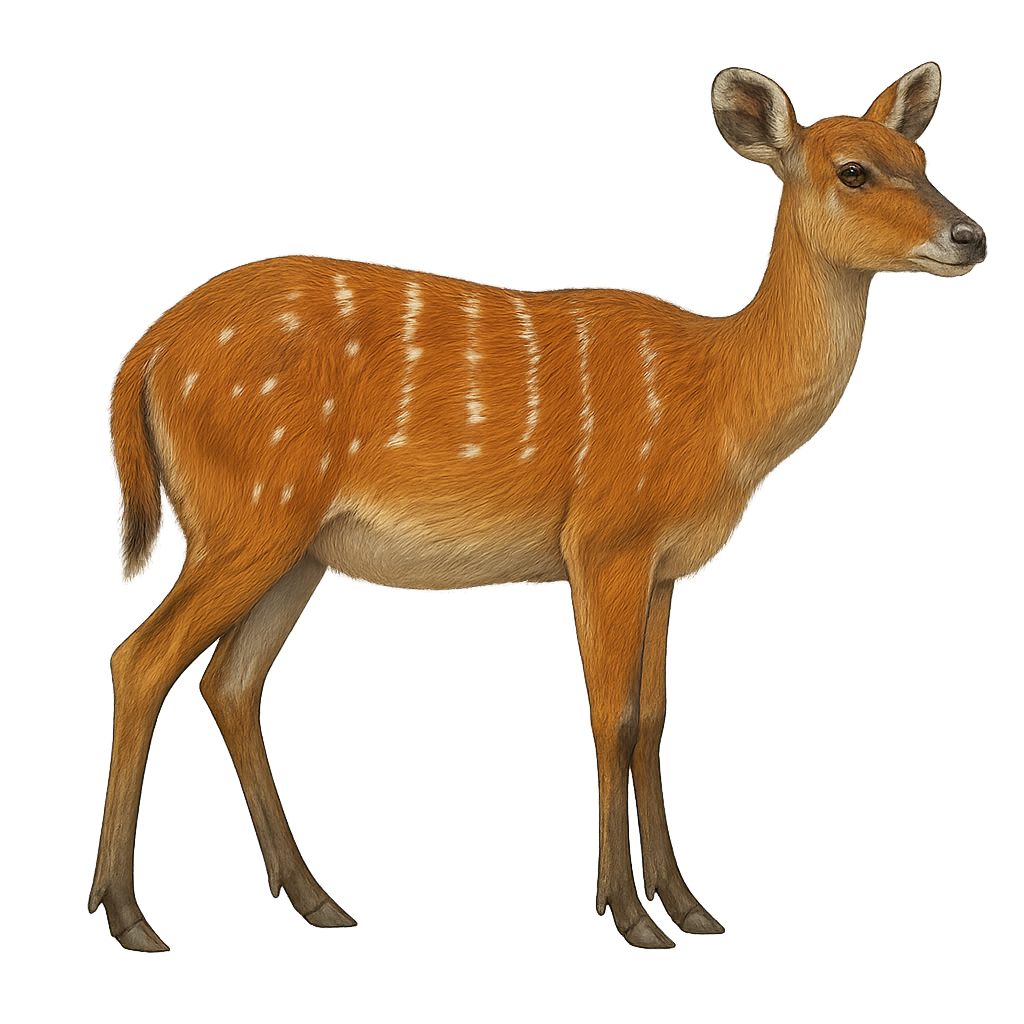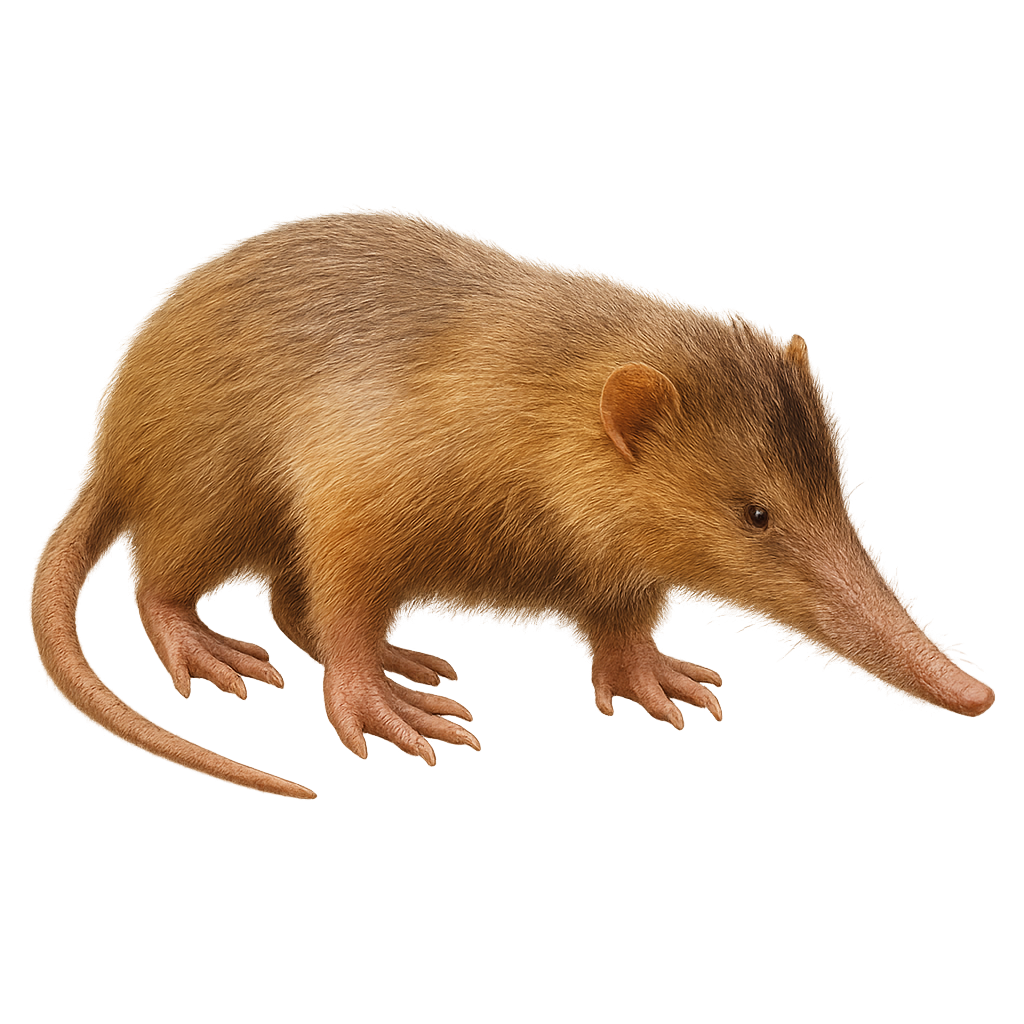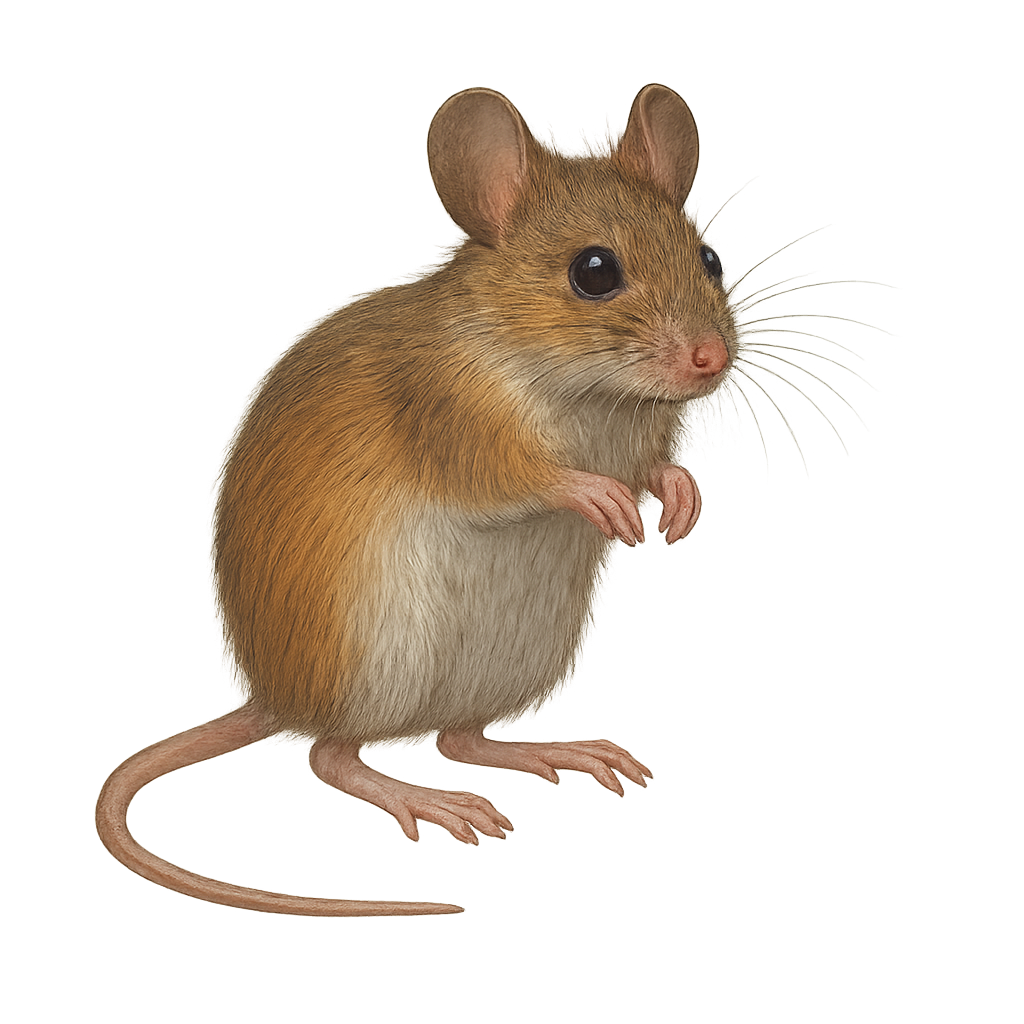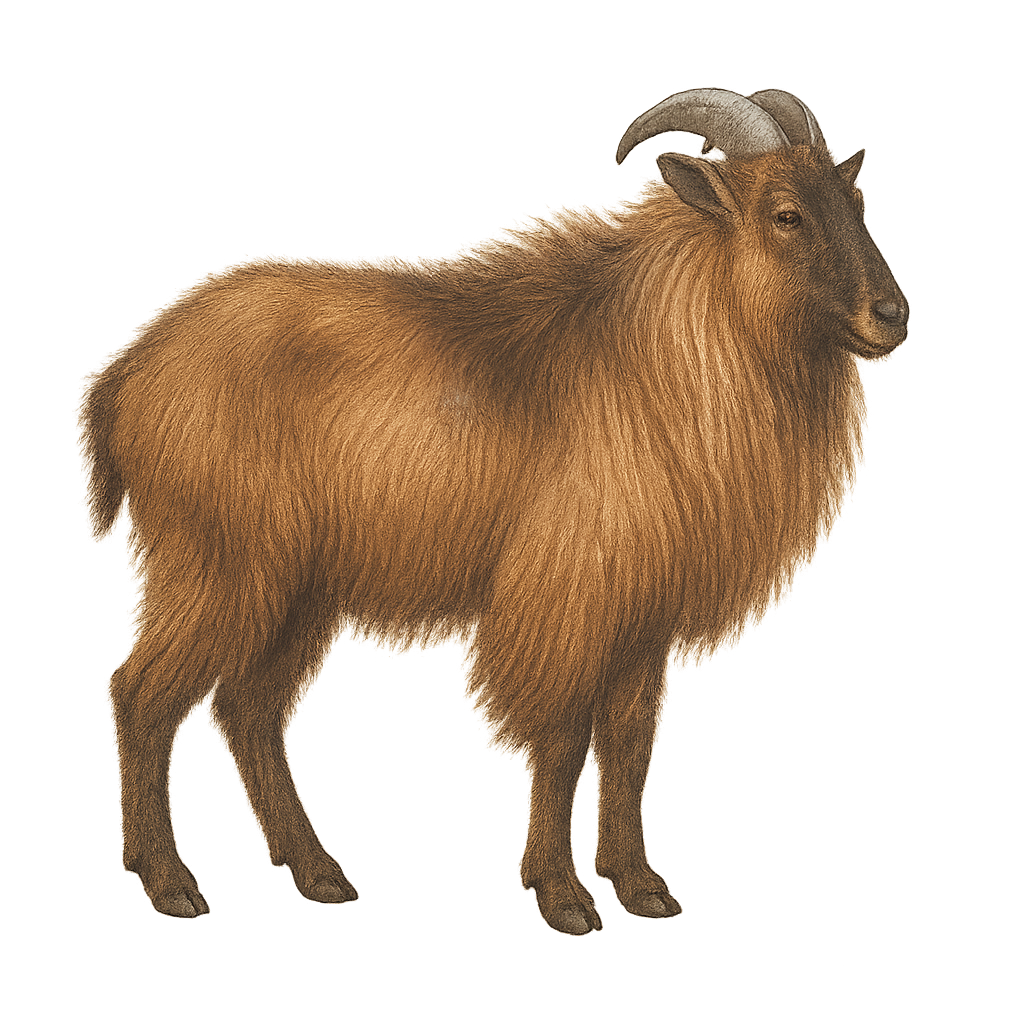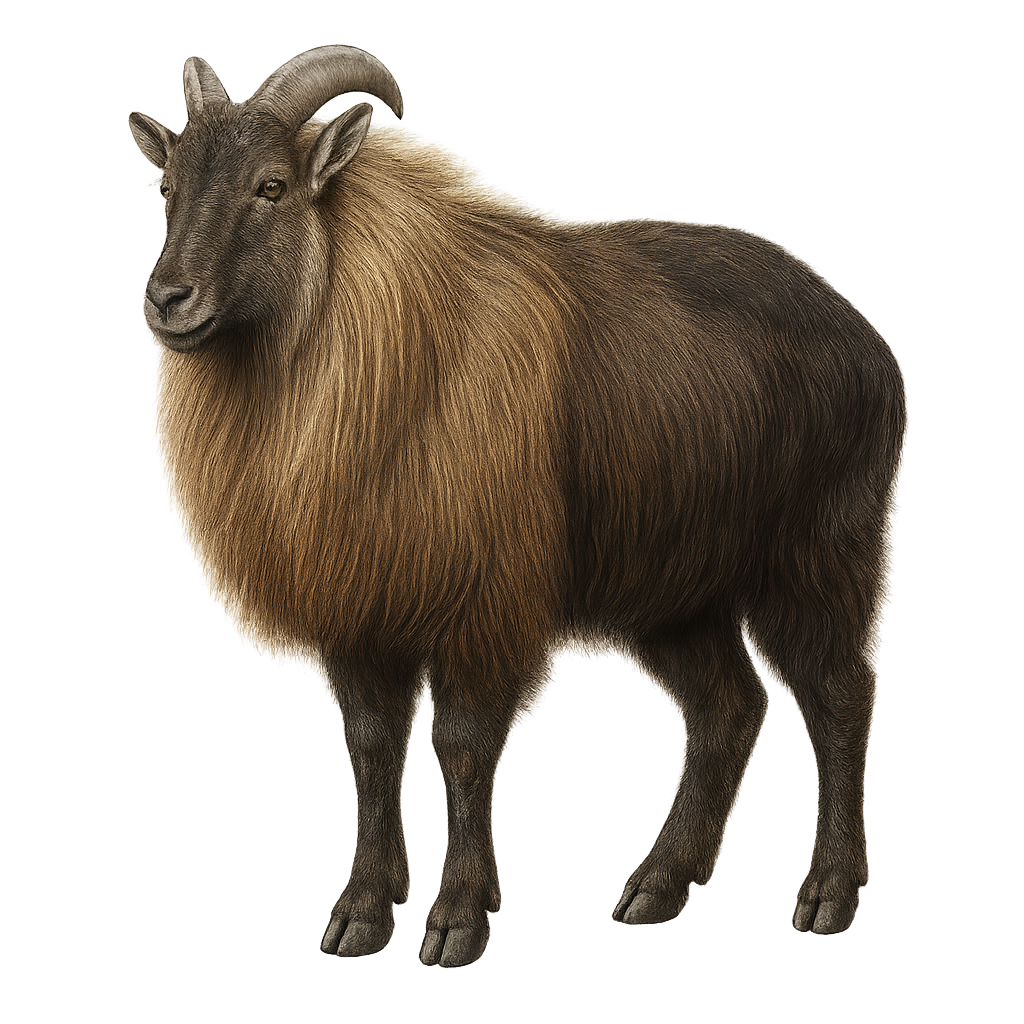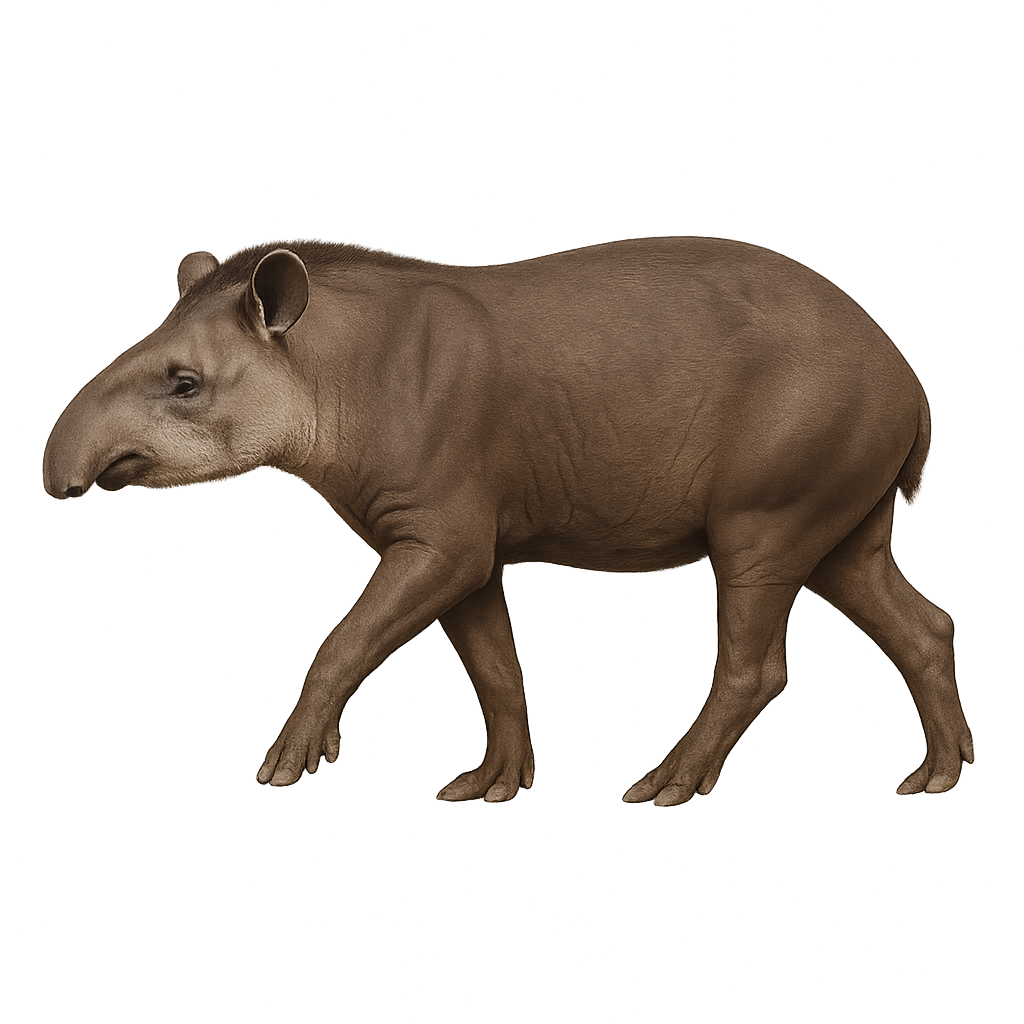The Northern Bat, Eptesicus nilssonii, is a medium-sized bat found in northern Europe and Asia. It is characterized by its dark brown fur, which is often lighter on the belly, and relatively short ears. It primarily inhabits coniferous forests but can also be found in urban areas, using buildings for roosting. This nocturnal species feeds on insects, which it catches in flight using sophisticated echolocation. It is mainly active during summer nights, while it hibernates in winter in caves or abandoned buildings. Although its conservation status is currently considered "least concern," it remains sensitive to human disturbances and the loss of its natural habitat.
The Serval is a medium-sized feline primarily found in the savannas and grasslands of sub-Saharan Africa, notably in East and Central Africa. It typically measures between 60 and 100 cm in length, with a tail of 30 to 40 cm, and weighs between 9 and 18 kg. Its coat is golden yellow, speckled with irregular black spots, which helps it camouflage effectively in its natural environment. The Serval has long legs, a small head, and large ears, which allow it to easily detect its prey, including small mammals, birds, and reptiles. It is also capable of impressive leaps to catch its prey, particularly birds in flight. While its population remains stable in some areas, the Serval is threatened by habitat loss and illegal hunting.
The Geoffroy's Spider Monkey is a medium-sized primate primarily found in the tropical forests of Mexico and Central America. It typically measures about 50 to 60 cm in length, with a prehensile tail of around 70 to 80 cm, and weighs between 10 and 20 kg. Its fur is generally brown or black, with lighter spots on the belly and legs. The Geoffroy's Spider Monkey has a highly flexible and prehensile tail, which it uses to grasp tree branches and move easily through the forest canopy. It is primarily herbivorous, feeding on fruits, leaves, flowers, and sometimes small insects. These monkeys live in organized social groups and are primarily active during the day. While they are relatively numerous, they are threatened by deforestation and loss of their natural habitat.
The Snow Monkey, also known as the Japanese macaque, is a species of primate primarily found in the mountains and snowy regions of Japan. It measures about 50 to 60 cm in length, with a tail of 20 to 25 cm, and weighs between 10 and 14 kg. Its fur is dense and thick, typically brown or gray, with a reddish face that becomes more pronounced in males, especially during the breeding season. The Snow Monkey lives in complex social groups and is especially known for its social behaviors, notably bathing in hot springs during the winter, which has become one of the most iconic images of Japan. It primarily feeds on fruits, roots, seeds, and sometimes small animals. While its population remains relatively stable, this species sometimes faces habitat loss and conflicts with human populations.
The Golden Monkey, also known as the Roxellana Rhinopithecus, is a medium-sized primate found primarily in the mountains of China, particularly in the provinces of Sichuan and Gansu. It measures about 55 to 70 cm in length, with a tail of 50 to 60 cm, and weighs between 10 and 15 kg. Its fur is a bright golden color, with reddish hues and long hair around the face that forms a kind of mane. The Golden Monkey is primarily herbivorous, feeding on leaves, fruits, seeds, and occasionally small insects. It lives in organized social groups and is often observed in mountainous forests at high altitudes. While it is protected in certain regions, this species is threatened by habitat loss, deforestation, and poaching, which has led to a decline in its population.
The Saimiri sciureus, or common squirrel monkey, is a small arboreal primate native to South America. It is characterized by its dense, soft fur, primarily gray-olive with shades of yellow and white. Its head features a white facial mask contrasting with a black crown. This monkey is highly agile and spends most of its time in the canopy of tropical forests, feeding mainly on fruits, insects, and small vertebrates. Social groups typically consist of 20 to 50 individuals, allowing them to effectively protect against predators. Although they are primarily active during the day, they can sometimes be observed at dusk.
The Central American Squirrel Monkey, or Saimiri oerstedii, is a small primate primarily found in the tropical rainforests of Costa Rica and Panama. Recognizable by its reddish back and white face bordered with black, it is highly agile and spends most of its time in the canopy. This monkey lives in social groups that can number up to 70 individuals, which helps protect it from predators. It primarily feeds on fruits, insects, and small vertebrates. Although its habitat is threatened by deforestation, conservation efforts are underway to protect this iconic species of Neotropical biodiversity.
The Howler Monkey is a medium-sized primate found primarily in the tropical forests of Central and South America, notably in Mexico, Central America, and parts of the Amazon rainforest. It typically measures about 40 to 70 cm in length, with a prehensile tail of 50 to 75 cm, and weighs between 7 and 10 kg. Its fur varies from black to brown, and it has a large throat and powerful jaw, which allow it to produce extremely loud sounds, used to demarcate territory and communicate with other members of its group. The Howler Monkey is primarily herbivorous, feeding on leaves, fruits, and flowers. It lives in social groups and is primarily active during the day, moving slowly from tree to tree. While its population remains relatively stable, this species is threatened by deforestation and hunting.
The Alouatta palliata, commonly known as the mantled howler, is an arboreal primate primarily found in the tropical forests of Central and South America. Recognizable by its powerful howl that can be heard for miles, it plays a crucial role in seed dispersal, aiding forest regeneration. This monkey has a black coat with a distinctive golden mane. It lives in hierarchical social groups composed of several males and females. Howler monkeys are primarily herbivorous, feeding on leaves, fruits, and flowers. Their vocal behavior is essential for intra-group communication and territorial defense. Although their population is stable, deforestation poses a threat to their natural habitat.
The Macaca silenus, or lion-tailed macaque, is a primate endemic to the Western Ghats of India. Recognizable by its silver mane surrounding a black face, it is one of the most distinctive macaques. Its tail, reminiscent of a lion's, is another characteristic feature. This macaque primarily inhabits tropical rainforests, spending most of its time in the canopy. It is omnivorous, feeding on fruits, leaves, insects, and small vertebrates. Unfortunately, it is threatened by deforestation and habitat fragmentation, leading to a significant decline in its population. Conservation efforts are crucial for its survival.
The patas monkey, or Erythrocebus patas, is an African primate known for its exceptional speed, reaching up to 55 km/h, making it the fastest monkey in the world. It has distinctive reddish fur, a black face, and long, slender limbs adapted for running. Males are significantly larger than females. They primarily inhabit the savannas and semi-arid regions of West and East Africa. Their diet is omnivorous, consisting of fruits, seeds, insects, and small animals. Patas monkeys are diurnal and spend most of their time on the ground, although they can climb trees to feed or rest.
The Tibetan macaque, or Macaca thibetana, is a robust and imposing primate native to the mountainous forests of China. It is distinguished by its thick fur, ranging from golden brown to gray, and its bare, pinkish face. Males are significantly larger than females, sometimes reaching 13 kg. These macaques live in complex social groups led by a dominant male. They are omnivorous, feeding on fruits, leaves, insects, and occasionally small animals. Their habitat is generally between 800 and 2500 meters in altitude, where they adapt to climatic variations. Although their population is stable, deforestation and hunting pose potential threats.
The Callicebus personatus, commonly known as the masked titi monkey, is a medium-sized primate native to the tropical forests of southeastern Brazil. It is characterized by its dark face surrounded by dense, silky brownish fur. These monkeys live in small family groups and are known for their strong social bonds, often seen grooming each other. They primarily feed on fruits, but their diet also includes leaves and insects. Their natural habitat is threatened by deforestation, leading to a decline in their population. Despite this, they sometimes adapt to fragmented forest areas.
The white-bellied spider monkey, Ateles belzebuth, is an arboreal primate primarily inhabiting the tropical forests of South America. Recognizable by its black fur and distinctive white face, it has long limbs and a prehensile tail that enable agile movement through the canopy. This social monkey lives in groups of up to 30 individuals, although they often split into smaller subgroups to forage. Primarily frugivorous, it also consumes leaves, flowers, and insects. Unfortunately, Ateles belzebuth is threatened by deforestation and hunting, leading to a decline in its population.
The Macaca sinica, commonly known as the toque macaque, is a primate species endemic to Sri Lanka. Recognizable by its tuft of hair on the top of its head, this monkey has a golden-brown coat with a lighter belly. It primarily inhabits tropical forests but also adapts to urban and agricultural areas. Highly social, it lives in hierarchical groups where females dominate. Its diet is omnivorous, consisting of fruits, leaves, insects, and occasionally small vertebrates. Unfortunately, deforestation and human expansion threaten its natural habitat, classifying it as vulnerable according to the IUCN.
Chlorocebus pygerythrus, commonly known as the vervet monkey, is a medium-sized primate found primarily in sub-Saharan Africa. It is characterized by its grey-green fur, black face surrounded by white hair, and long, slender tail. These monkeys are highly adaptable and can inhabit a variety of environments, from savannas to riverine forests. They are known for their intelligence and ability to adapt to urban settings. Vervets live in complex social groups where hierarchy and communication play a crucial role. They are diurnal, spending most of the day foraging for food, which mainly consists of fruits, leaves, and insects.
The sitatunga, or Tragelaphus spekii, is a semi-aquatic antelope found mainly in the marshes and wetlands of Central and East Africa. It is easily recognizable by its reddish-brown coat, vertical white stripes, and long spiraled horns in males. Sitatungas are well adapted to their aquatic habitat, with long, splayed hooves that allow them to move easily through swamps. They are primarily active at dawn and dusk, feeding on aquatic plants, grasses, and leaves. Sitatungas are shy and elusive animals, preferring to remain hidden in dense vegetation to avoid predators.
The Hispaniolan solenodon (Solenodon paradoxus) is a venomous insectivorous mammal resembling a shrew, endemic to the Caribbean island of Hispaniola (Dominican Republic and Haiti). It inhabits moist forests, shelters in burrows or under logs, and feeds primarily on arthropods, worms, molluscs and small vertebrates. Crepuscular and nocturnal, it moves in a zigzag gallop and produces varied vocalizations for communication and defense.
The yellow-necked mouse, Apodemus flavicollis, is a small rodent belonging to the Muridae family. It is characterized by a distinctive yellow band around its neck, contrasting with its reddish-brown back and white belly. Primarily nocturnal, it inhabits forests, hedgerows, and sometimes gardens. Its diet includes seeds, fruits, and insects. Agile and fast, it can evade predators effectively. It reproduces several times a year, with litters of 4 to 7 young. Although common, it plays a crucial role in the ecosystem by dispersing seeds and controlling insect populations.
The Springbok is a small antelope found primarily in the savannas and grasslands of South Africa, Namibia, and Botswana. It typically stands about 75 cm at the shoulder, with a body length of 1.10 to 1.30 meters, and weighs between 30 and 40 kg. Its coat is primarily white and brown, with a dark line running along its back and a large white patch on its sides. What sets the Springbok apart is its ability to perform characteristic jumps, known as "pronking," where the animal leaps into the air with its legs extended, often to signal danger or to impress another individual. The Springbok is herbivorous, feeding primarily on grass and leaves. While it remains relatively abundant in its habitat, it is sometimes threatened by hunting and habitat loss.
The Céphalophe de Grimm is a small antelope found primarily in dry regions and open savannas of sub-Saharan Africa, particularly in countries such as South Africa, Botswana, and Namibia. It typically stands about 45 to 60 cm at the shoulder, with a body length of 80 to 100 cm, and weighs between 8 and 15 kg. Its coat is generally fawn to light brown, with white markings on its legs and around its eyes. The Céphalophe de Grimm has small horns in males, but they are generally more discreet than those of other antelope species. This small herbivore feeds primarily on grasses, fruits, and leaves. It is known for its ability to hide in dense vegetation and escape quickly from predators. While its population remains relatively stable, the Céphalophe de Grimm is sometimes threatened by habitat loss and hunting.
The Meerkat is a small carnivorous mammal primarily found in the dry and desert regions of southern Africa, notably in South Africa, Botswana, and Namibia. It typically measures about 25 to 35 cm in length, with a tail of 20 to 25 cm, and weighs between 0.6 and 1 kg. Its fur is gray-brown, with lighter spots on the belly, and it has a small head and large black eyes. The Meerkat is especially known for its characteristic posture, standing on its hind legs to survey its surroundings. It lives in organized social groups, called "clans," and primarily feeds on insects, small reptiles, and fruits. While its population remains relatively stable, the Meerkat is threatened by habitat loss and human disturbances.
The Arabian tahr, Hemitragus jayakari, is a species of wild goat native to the arid mountains of Oman and the United Arab Emirates. This robust mammal is well adapted to rugged, rocky terrains, where it primarily feeds on grasses, leaves, and fruits. Males are distinguished by their thick, curved horns, while females have smaller horns. Its dense, brownish coat allows it to blend into its rocky environment. The Arabian tahr is a gregarious animal, living in small groups, although adult males are often solitary. This species is threatened by habitat loss and hunting, leading to its classification as vulnerable by the IUCN.
The Himalayan tahr, Hemitragus jemlahicus, is a robust caprine native to the rugged mountains of the Himalayas. With a thick, woolly coat, it is well-suited to the cold, windy conditions of its habitat. Males are distinguished by their impressive manes and curved horns, while females are smaller with more modest horns. These gregarious animals form herds, often segregated by sex, and navigate difficult terrains with remarkable agility. Their diet mainly consists of grasses, leaves, and shoots. Although their population is stable, they face threats from hunting and habitat loss.
The Takin is a large herbivore found primarily in the mountainous regions of the Himalayas and China. It typically stands between 1.2 and 1.5 meters at the shoulder, with a body length of 1.5 to 2 meters, and weighs between 250 and 350 kg. Its fur is dense and ranges from golden to light brown, with longer hair around the throat and shoulders, giving it a robust appearance. The Takin is an excellent climber and primarily feeds on woody vegetation, leaves, young shoots, and fruits. It lives in social groups and is mainly active at dawn and dusk. While its population remains relatively stable in certain areas, this species is threatened by deforestation and human activities, including hunting and encroachment on its natural habitat.
The Southern Tamandua is an arboreal anteater found primarily in South America. It is recognizable by its beige and black fur, which allows it to blend into the trees. It has a long sticky tongue, ideal for capturing ants and termites, which make up the bulk of its diet. This mammal is mainly nocturnal and spends the day resting in trees. Although generally solitary, it can sometimes be seen in pairs. Its prehensile tail allows it to move easily through the trees, and it uses its powerful claws to defend itself against predators.
The Mexican Tamandua, or Tamandua mexicana, is an insectivorous mammal primarily found in the tropical and subtropical forests of Mexico, Guatemala, and Honduras. It typically measures between 50 and 70 cm in length, with a tail of 40 to 50 cm, and weighs between 4 and 7 kg. Its fur is generally yellow-brown, with a black mask around the eyes and a wide black band on its back. This tamandua has a long tongue, which can reach up to 40 cm, used to catch termites and ants, its main food source. The Mexican Tamandua is also an excellent climber, spending much of its time in trees. It is generally nocturnal and primarily feeds on insects and occasionally fruits. While its population remains relatively stable, it is sometimes threatened by deforestation and the loss of its natural habitat.
The Golden Lion Tamarin is a small primate found primarily in the tropical forests of southeastern Brazil. It typically measures about 20 to 30 cm in length, with a tail of 35 to 45 cm, and weighs between 500 and 700 g. Its fur is a bright golden orange, giving it a distinctive and striking appearance. The Golden Lion Tamarin is known for its small size, great agility, and complex social behaviors. It lives in family groups and primarily feeds on fruits, insects, nectar, and small vertebrates. Although it is an excellent climber and spends most of its time in trees, this species is threatened by deforestation, habitat loss, and illegal wildlife trade.
The Baird's Tapir is a species of tapir found primarily in the tropical forests of Central America, notably in Guatemala, Honduras, Costa Rica, and Nicaragua. It typically measures about 2 to 2.5 meters in length, with a short tail of 20 to 30 cm, and weighs between 200 and 300 kg. Its fur is predominantly black or dark brown, with lighter areas on its legs and ears. The Baird's Tapir has a long, flexible snout that allows it to grasp leaves, fruits, branches, and grasses. While it is an excellent swimmer and often spends time in water, it primarily lives in dense, humid forests. This species is threatened by deforestation, illegal hunting, and habitat loss, which has led to a decline in its population.
The Brazilian tapir, also known as the Amazonian tapir, is a large herbivorous mammal that lives in the humid tropical forests and wetland areas of the Amazon basin. It is easily recognized by its massive body, short legs, and elongated trunk-like nose, which it uses to grasp branches and leaves. The Brazilian tapir is primarily nocturnal and solitary, feeding mainly on fruits, leaves, and roots. While rather calm, it is an excellent swimmer and often spends time in water to cool off or move around. This tapir is currently listed as vulnerable due to habitat loss and hunting.


